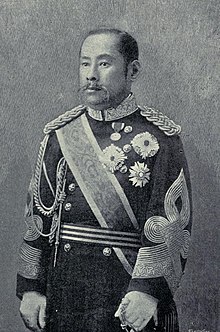Prince Arisugawa Taruhito
His Imperial Highness Prince Arisugawa Taruhito | |
|---|---|
有栖川宮熾仁親王 | |
 General Prince Arisugawa Taruhito | |
| Chief of the Imperial Japanese Army General Staff Office | |
| In office December 22, 1885 – May 14, 1888 | |
| Monarch | Meiji |
| Preceded by | Yamagata Aritomo |
| Succeeded by | Ozawa Takeo[note 1] |
| In office March 9, 1889 – January 15, 1895 | |
| Monarch | Meiji |
| Preceded by | Ozawa Takeo[note 2] |
| Succeeded by | Prince Komatsu Akihito |
| Personal details | |
| Born | March 17, 1835 Kyoto, Japan |
| Died | January 15, 1895 (aged 59) Kobe, Japan |
| Awards | Collar of the Supreme Order of the Chrysanthemum |
| Military service | |
| Allegiance | |
| Branch/service | |
| Years of service | 1867–1895 |
| Rank | General |
| Commands | Imperial Japanese Army |
| Battles/wars | |

Prince Arisugawa Taruhito (有栖川宮熾仁親王, Arisugawa-no-miya Taruhito-Shinnō, March 17, 1835 – January 15, 1895) was a Japanese career officer in the
Early life
Prince Arisugawa Taruhito was born in Kyoto in 1835, as the son of Prince Arisugawa Takahito by Yūko (d. 1841), the eldest daughter of Saeki Yūjō. He was adopted by Emperor Ninkō as a potential heir to the throne, thus making Taruhito the adopted brother of Osahito Shinnō (the future Emperor Kōmei). Arisugawa was a close advisor to both Emperor Kōmei and his nephew by adoption, Emperor Meiji.
Prince Arisugawa became engaged to Princess
Arisugawa's first wife Sadako (1850–1872) was the eleventh daughter of
Meiji Restoration
In 1867 Emperor Meiji appointed Prince Arisugawa
From 1870 until the adoption of the Cabinet system in 1885, Arisugawa served as
From 1889 to 1895 the prince served as chief of staff of the Imperial Japanese Army and a member of the Supreme War Council.

In 1894 Prince Arisugawa was officially commander-in-chief of Japanese forces in the First Sino-Japanese War, and established his command center at the Hiroshima garrison. He contracted typhoid fever (or possibly malaria) and returned to the Arisugawa palace at Maiko near Kobe to recover, but he died there on January 15, 1895. On his death, Emperor Meiji awarded him the first ever Collar of the Supreme Order of the Chrysanthemum.[1] He was accorded a state funeral in Tokyo on January 29, 1895. His half-brother, Prince Arisugawa Takehito, succeeded as the tenth head of the house of Arisugawa-no-miya.
Legacy
The
Notes
- ^ Dupuy, Encyclopedia of Military Biography
References
- Dupuy, Trevor N. (1992). Encyclopedia of Military Biography. I B Tauris & Co Ltd. ISBN 1-85043-569-3.
- OCLC 44090600.
- OCLC 46731178.
Notes
- ^ No Wikipedia page has been created for Lieutenant General Ozawa Takeo, the 5th Chief of Staff of the Imperial Japanese Army. Consequently, clicking on his name connects to the page for the Imperial Japanese Army General Staff Office which contains a comprehensive list of all its chiefs from 1878 to 1945.
- ^ See Note 1.
